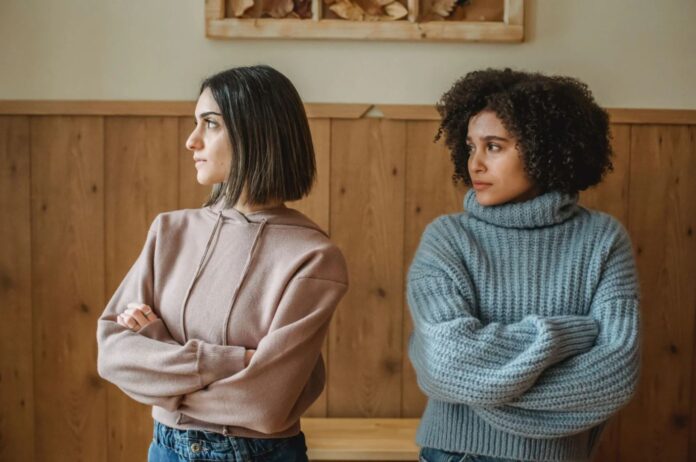What is it about some people that can walk into any room and “own” it? You’ve probably seen them before: men and women with commanding presences that radiate confidence and poise, regardless of the setting.
The answer is not that these people are more physically attractive or that they have more money or status. It turns out that 70 to 90% of our communications with other people are non-verbal, meaning that body language — from your facial expressions to your body movement — reveals a lot more about you than what you choose to say (or not) with your words.
A truly universal language
Forget English, Mandarin, and even music: body language is the real universal language spoken by every person in the world, regardless of their age, gender, culture, or physical condition. It’s sometimes called nonverbal communication because, just like verbal communication, it is a means of transmitting information to other people.
The main difference, though, is that body language allows you to convey your thoughts, feelings, or ideas through physical gestures, like eye contact, facial expressions, posture, hand gestures, and more. Verbal communication, on the other hand, involves the use of words, sounds, and intonation to share information with others.
Another key difference is that body language, unlike verbal communication, can be unconscious and spontaneous. In other words, many of your nonverbal cues are involuntary and can give away what you’re thinking or feeling and even undermine your credibility and intentions.
Body language is a complex reflex linked with a number of other processes in the brain. Facial expressions are processed in the amygdala and specific visual areas of the brain. Other areas, like the extrastriate body area (EBA) and the ace fusiform body areas (FBA), also seem to activate in response to emotional body language signaling emotions like happiness, anger, and disgust.
Although some nonverbal cues cannot be controlled, you can actually improve your body language and use it to present a more positive image of yourself. Using body language properly can help you appear more confident and approachable and allows you to build stronger connections with others.
Types of body language and what they say about you
Being aware of your nonverbal cues is an excellent way of ensuring that your body language works for you, not against you. But paying attention to how others “talk” with their bodies is also a powerful tool that can help you navigate social and professional situations with ease. Here are the 5 most common subtle and not-so-subtle types of body language that people use and what they mean.
Eye contact and movements
Eye contact is crucial for both verbal and nonverbal communication. Not for nothing, folks have been calling the eyes the “windows to the soul” for ages. Good eye contact shows people you’re welcoming and interested in what they are saying. And it also makes people more likely to believe and remember what you said long after the conversation has ended. On the other hand, a lack of eye contact could signify shyness, anxiety, or untrustworthiness.
There’s also some evidence that eye movements — as in the speed, direction, and blink rate — also carry a lot of meaning. For example, eyes that dart from side to side might signal that the person is uncomfortable and is unconsciously looking for an escape route. Winking is a common, cheeky form of flirting. And closing your eyes while talking, which is called “eye blocking,” could be interpreted as a sign of lying, reluctance, or disagreement.
Mouth expressions
Mouth expressions can be incredibly telling, but they can also be tough to decode. For example, chewing your lower lip could be a sign of hesitation, anxiousness, or guilt. But many people also use it to appear flirtatious or sexy. Covering your mouth or smile with your hand is sometimes interpreted as shyness or insecurity, or that you’re trying to hide something. However, covering your mouth while laughing is seen as a standard, polite gesture in many cultures.
Laughing and smiling are considered universal signals of happiness. But in reality, humans use smiles in a variety of ways to convey all sorts of emotions. Here are a few of the most common smiles:
- Duchenne smile: known by many psychologists as the “true” smile of happiness.
- Fake smile: sometimes known as the “forced” smile, it is characterized by overly exposed teeth, and it’s often used in uncomfortable situations.
- Sarcastic smile: can look like a genuine smile, but the eyes often give it away. The sarcastic smile is always deliberate, meaning that it’s done intentionally and consciously.
- Uncomfortable smile: you’ve seen the meme before: an older man smiling awkwardly to the camera, with a “hiding the pain” look in his eyes. People usually use this smile in uncomfortable situations, like when someone says something inappropriate to cover up nerves or discomfort.
Posture
Posture and movement also make or break a first impression. For example, crossing the arms can indicate defensiveness. And crossing your legs away from another person can be a signal that you’re trying to create an imaginary barrier between you two. But the way you stand and carry yourself also conveys a great deal of information.
Placing your hands in your hips with the elbows pointing out and your feet hip-width apart (power pose) shows confidence, dominance, and self-assurance. On the other hand, slouching or leaning back can be a sign of being unfriendly, apathetic, or tired. Turning away your shoulders from the person you’re talking to is often seen as a naturally defensive posture, whereas hunched shoulders are considered a sign of submission.
Hand gestures
Have you noticed that leaders, TV reporters, and public speakers all leverage hand gestures to emphasize specific points and connect with their audiences? Studies show that hand gestures increase the value of your spoken language by as much as 60%. This means that just by using your hands, you can make your message more robust, clearer, and more effective.
Hand gestures carry different cultural meanings depending on where you live. For instance, the widely used “thumbs up” used as a sign of approval or agreement in the United States and other western countries can be highly offensive in other parts of the world. The same goes for the gesture made by touching your thumb and index finger together: scuba divers and folks in the U.S interpret it as “okay” or “all right,” but in certain parts of South America, the symbol is actually a vulgar sign.
These are some of the most common hand gestures and their meanings:
- Clenching fists tightly: anger, distress, intensity
- Fidgety fingers: anxiety, discomfort, lack of confidence
- Hands in pockets: dominance, aggression. Depending on hand placement might also signal weakness
- Hands forming a triangle or pyramid: confidence, thinking
- Wringing hands: nervousness, self-consciousness, hiding something
- Eye rubbing: disagreement
- Twisting hair: self-consciousness, flirting



